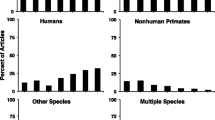Abstract
Ten years ago, a number of authors commented on the dismal state of the basic research area known as the experimental analysis of human behavior (EAHB). At that time, data on the number of research articles using human subjects published in the Journal of the Experimental Analysis of Behavior (JEAB) indicated little progress since the early 1960s. However, updated publication data through 1991 reveal that EAHB research has accelerated in the last decade, reaching a peak of nearly half of all research articles published in JEAB, with an increasing trend evident. The increase in this percentage is not due solely to a long-term declining trend in the total number of experimental articles in JEAB using either human or nonhuman subjects, a trend that appears to have slowed or stabilized in the last 6 years. These data indicate that the EAHB has made dramatic progress in a decade and is healthy and growing.
Similar content being viewed by others
References
Baron, A., & Perone, M. (1982). The place of the human subject in the operant laboratory. The Behavior Analyst, 5, 143–158.
Baron, A., Perone, M., & Galizio, M. (1991). Analyzing the reinforcement process at the human level: Can application and behavioristic interpretation replace laboratory research? The Behavior Analyst, 14, 95–105.
Buskist, W. F. (1983). Introduction. The Psychological Record, 33, 451–456.
Buskist, W. F., & Johnston, J. M. (1988). Laboratory lore and research practices in the experimental analysis of human behavior. The Behavior Analyst, 11, 41–42.
Buskist, W. F., & Miller, H. L. (1982). The analysis of human operant behavior: A brief census of the literature: 1958–1981. The Behavior Analyst, 5, 137–141.
Dinsmoor, J. A. (1991). The respective roles of human and nonhuman subjects in behavioral research. The Behavior Analyst, 14, 117–121.
Fantino, E. (1988). Editorial. Journal of the Experimental Analysis of Behavior, 49, 1–2.
Hake, D. F. (1982). The basic-applied continuum and the possible evolution of human operant social and verbal research. The Behavior Analyst, 5, 21–28.
Hayes, S. C. (1987). Upward and downward continuity: It’s time to change our strategic assumptions. Behavior Analysis, 22, 3–6.
Hayes, S. C. (1989a). Nonhumans have not yet shown stimulus equivalence. Journal of the Experimental Analysis of Behavior, 51, 385–392.
Hayes, S. C. (Ed.). (1989b). Rule-governed behavior: Cognition, contingencies, and instructional control New York: Plenum.
Hayes, S. C., Zettle, R. D., & Rosenfarb, I. (1989). Rule-following. In S. C. Hayes (Ed.), Rule-governed behavior: Cognition, contingencies, and instructional control (pp. 191–220). New York: Plenum.
Lattal, K. A., McFarland, J. M., & Joyce, J. H. (1990). What is happening in psychology of learning courses? The Behavior Analyst, 13, 121–130.
Lowe, C. F. (1979). Determinants of human operant behaviour. In M. D. Zeiler & P. Harzem (Eds.), Advances in analysis of behaviour: Vol. 1. Reinforcement and the organization of behaviour (pp. 159–192). Chichester, England: Wiley.
McIlvane, W. J., & Saunders, K. J. (1991). Editorial. Experimental Analysis of Human Behavior Bulletin, 9, 19–20.
McIntire, K. D., Cleary, J., & Thompson, T. (1989). Reply to Saunders and to Hayes. Journal of the Experimental Analysis of Behavior, 51, 393–396.
Michael, J. (1982). Distinguishing between discriminative and motivational functions of stimuli. Journal of the Experimental Analysis of Behavior, 37, 149–155.
Miller, H. L. (1983). More than promissory? Reflections on the once and future experimental analysis of human behavior. The Psychological Record, 33, 551–564.
Navarick, D., Bernstein, D., & Fantino, E. (1990). The experimental analysis of human behavior. Journal of the Experimental A nalysis of Behavior, 54, 159–162.
Nevin, J. A. (1982). Editorial. Journal of the Experimental Analysis of Behavior, 37, 1–2.
Saunders, K. J. (1989). Naming in conditional discrimination and stimulus equivalence. Journal of the Experimental Analysis of Behavior, 51, 379–384.
Sidman, M., Rauzin, R., Lazar, R., Cunningham, S., Tailby, W., & Carrigan, P. (1982). A search for symmetry in the conditional discrimination of rhesus monkeys, baboons, and children. Journal of the Experimental Analysis of Behavior, 37, 23–44.
Sidman, M., & Tailby, W. (1982). Conditional discrimination vs. matching to sample: An expansion of the testing paradigm. Journal of the Experimental Analysis of Behavior, 37, 5–22.
Vaughan, M. (1989). Rule-governed behavior in behavior analysis: A theoretical and experimental history. In S. C. Hayes (Ed.), Rule-governed behavior: Cognition, contingencies, and instructional control (pp. 97–118). New York: Plenum.
Vaughan, W. (1989). Reply to Hayes. Journal of the Experimental Analysis of Behavior, 51, 397.
Author information
Authors and Affiliations
Additional information
Portions of this paper were presented in an address by the first author entitled, “The Renaissance of Human Operant Research: An Overview of Rule-Governed Behavior and Stimulus Equivalence” at the meeting of the Texas Association for Behavior Analysis, Dallas, February, 1989.
Rights and permissions
About this article
Cite this article
Hyten, C., Reilly, M.P. The Renaissance of the Experimental Analysis of Human Behavior. BEHAV ANALYST 15, 109–114 (1992). https://doi.org/10.1007/BF03392593
Published:
Issue Date:
DOI: https://doi.org/10.1007/BF03392593




